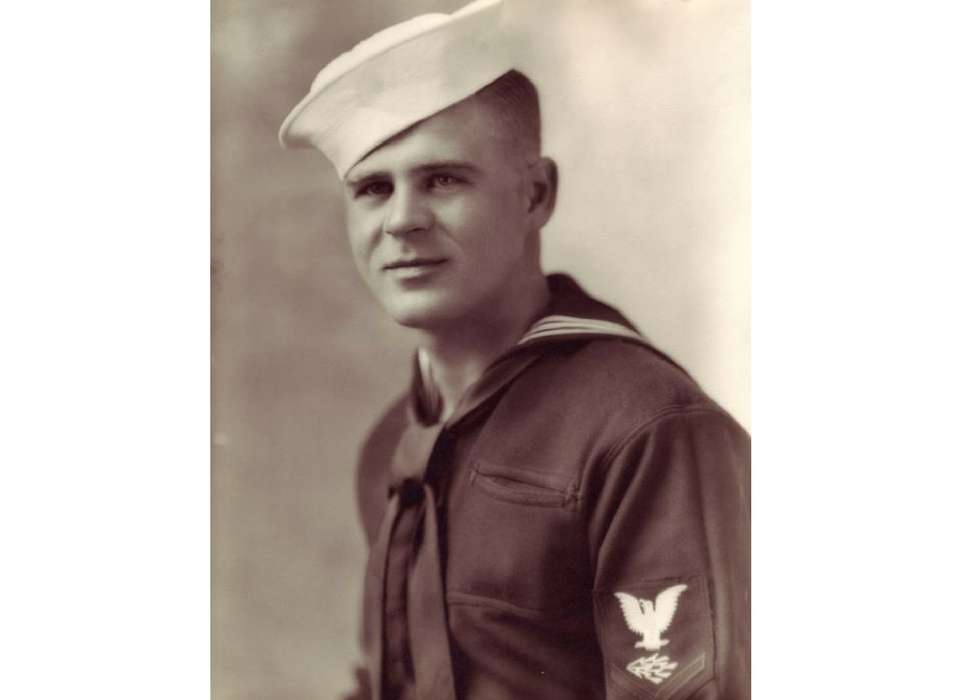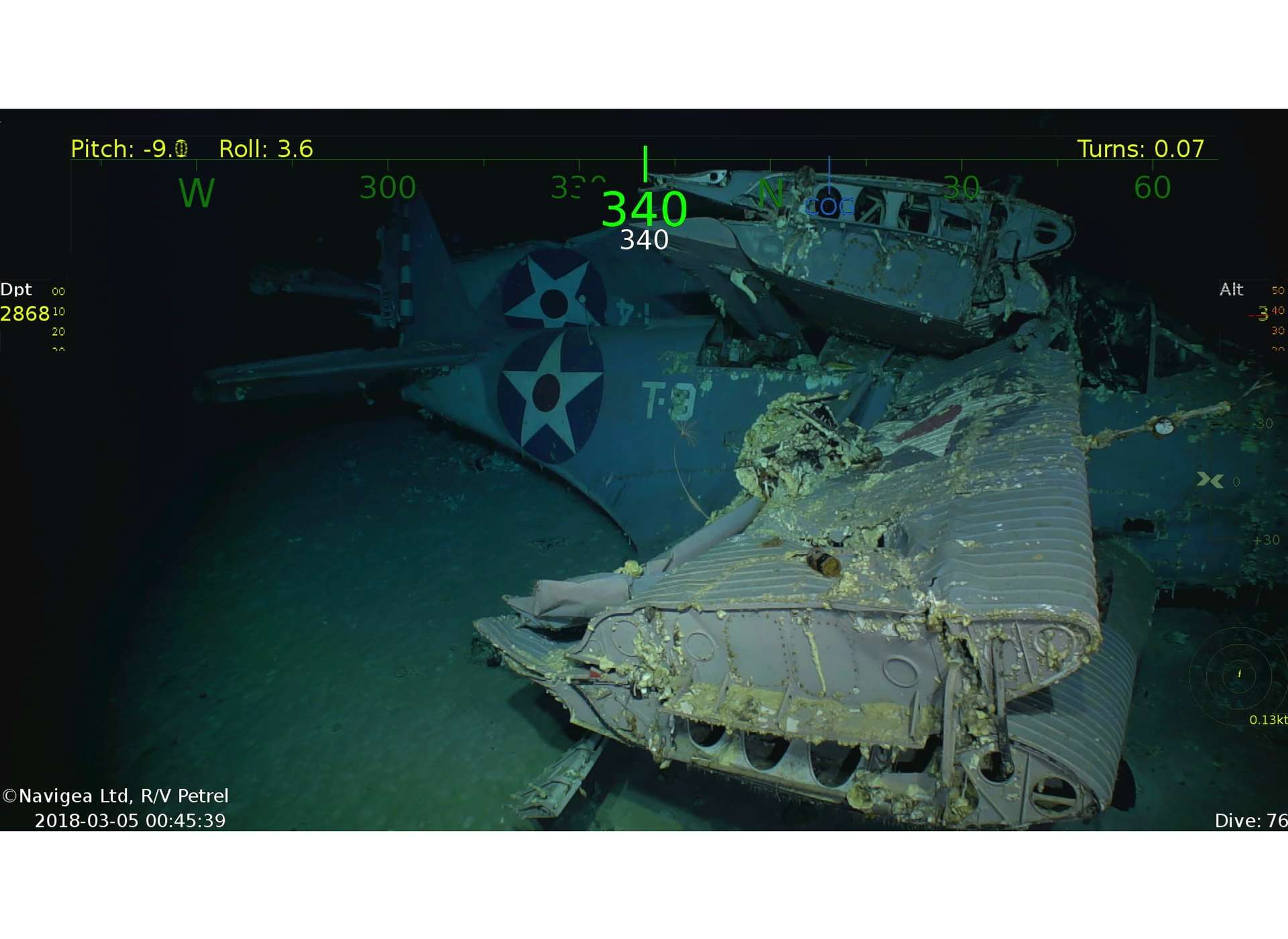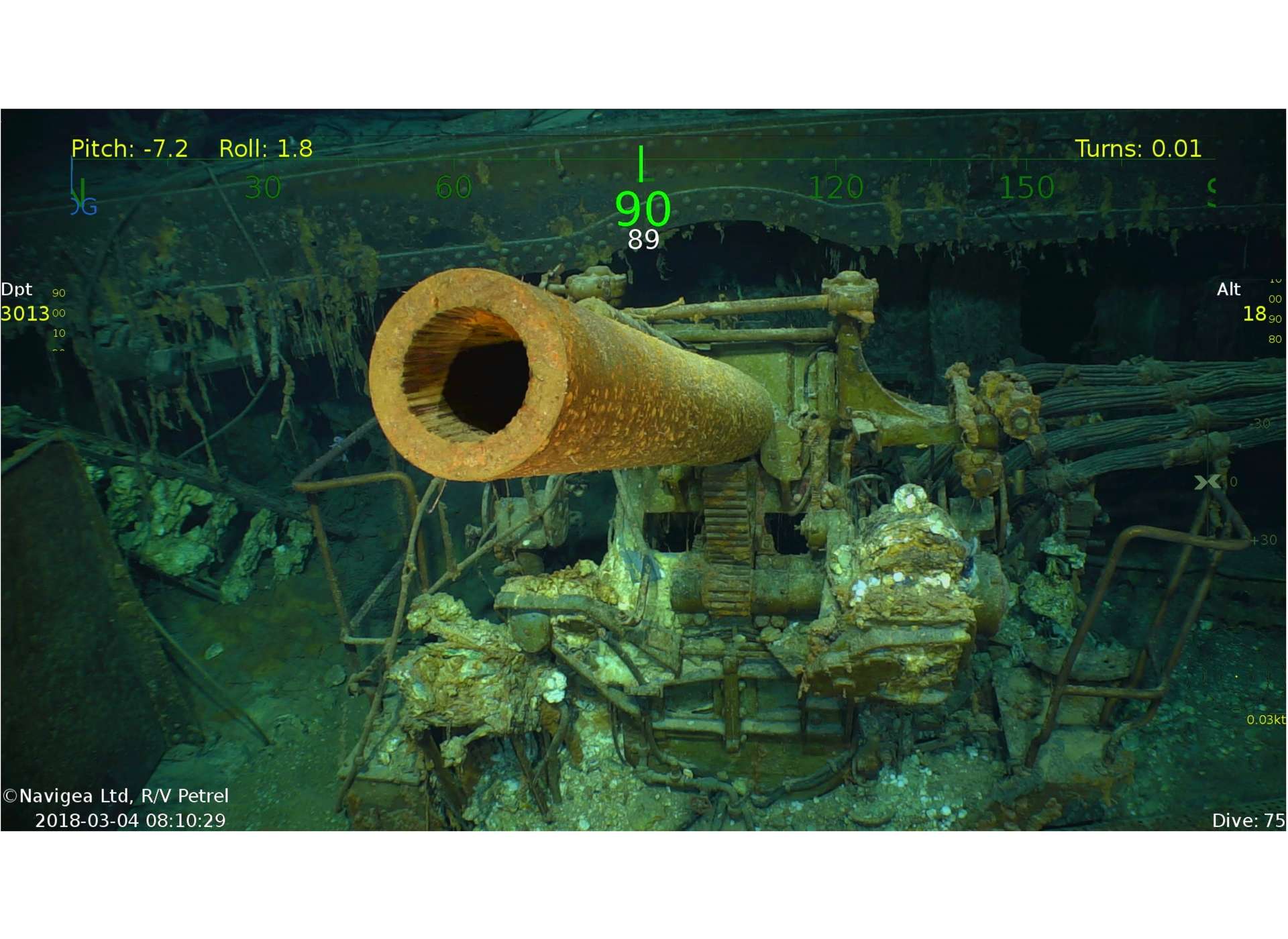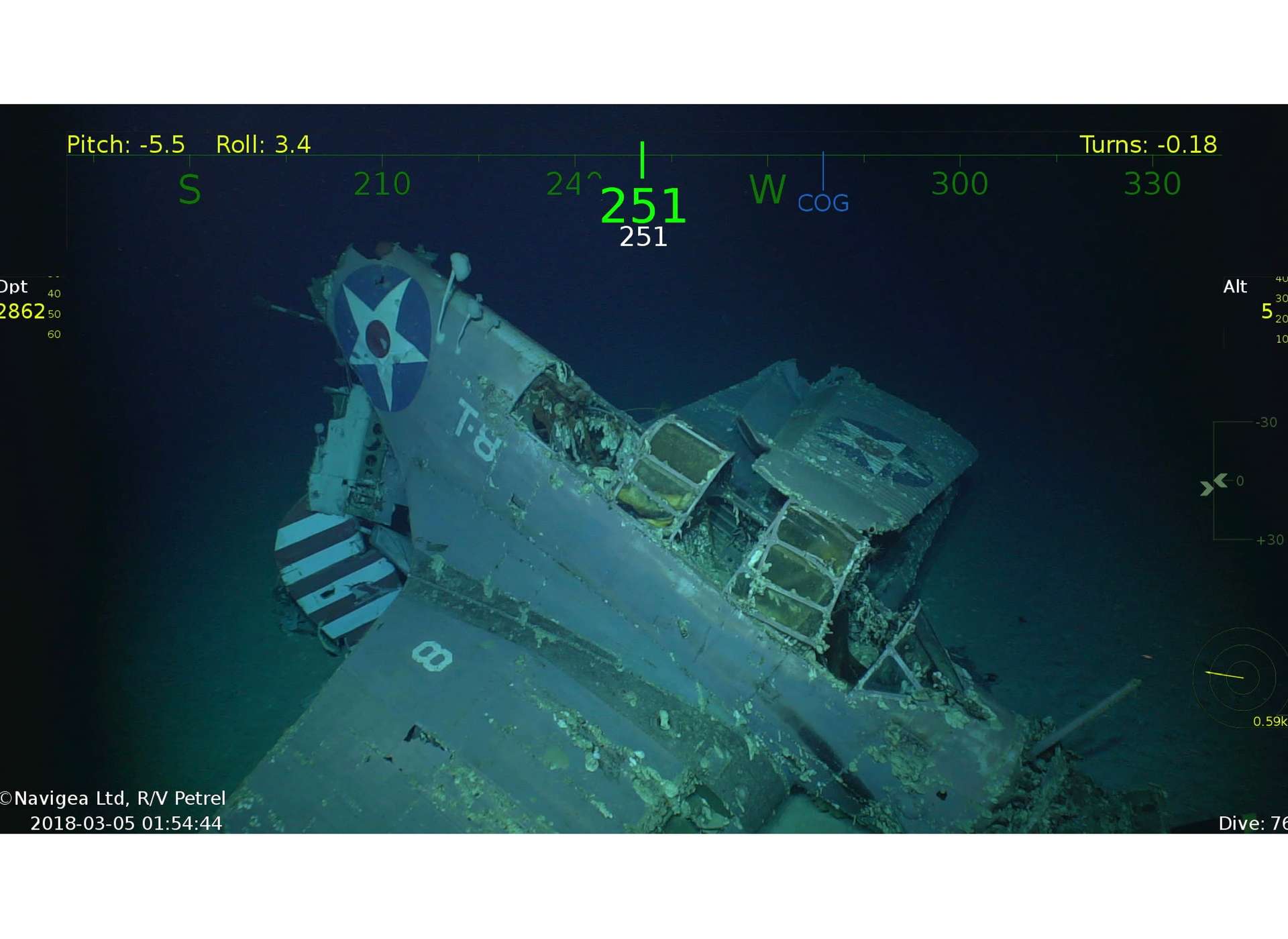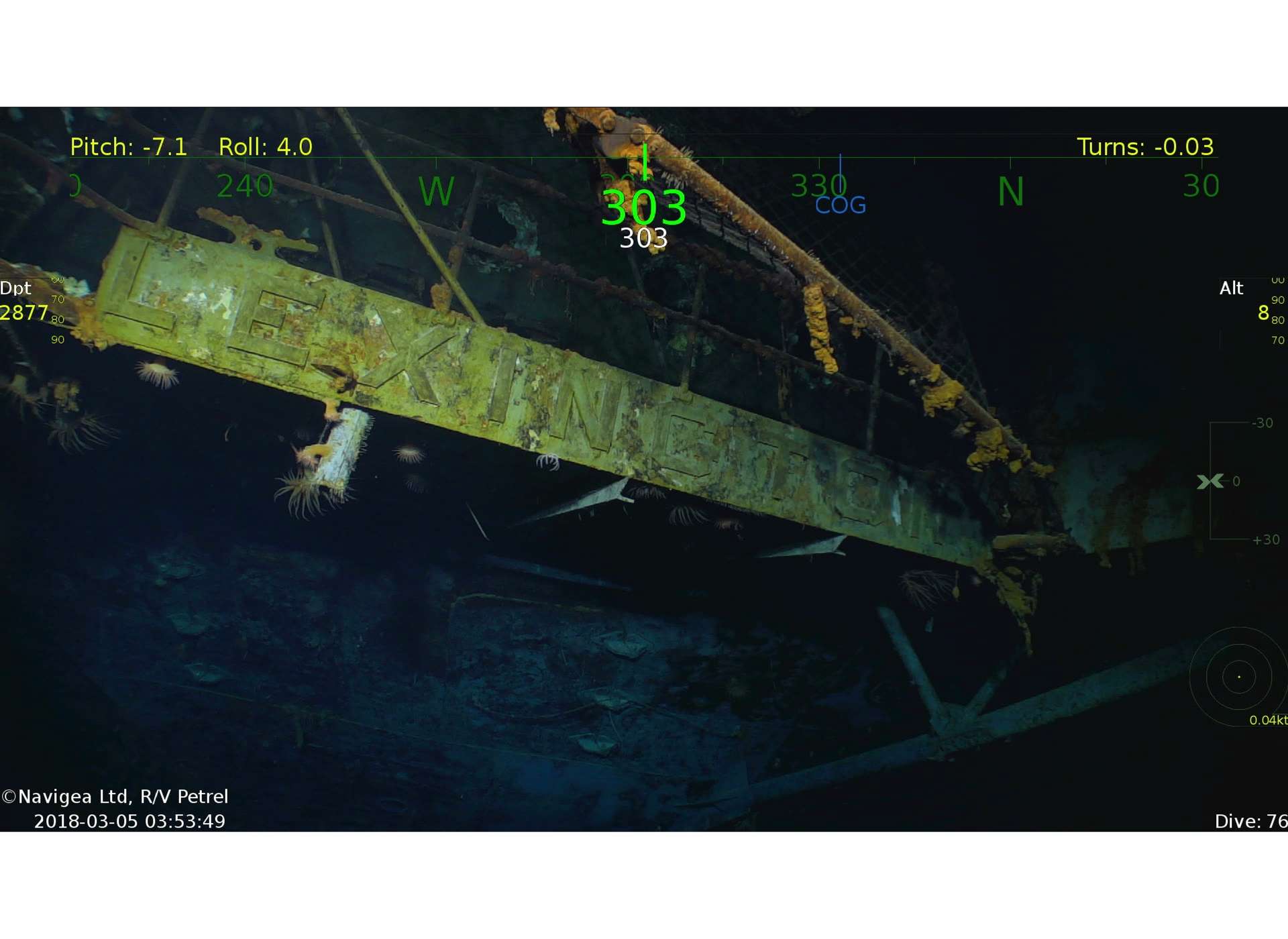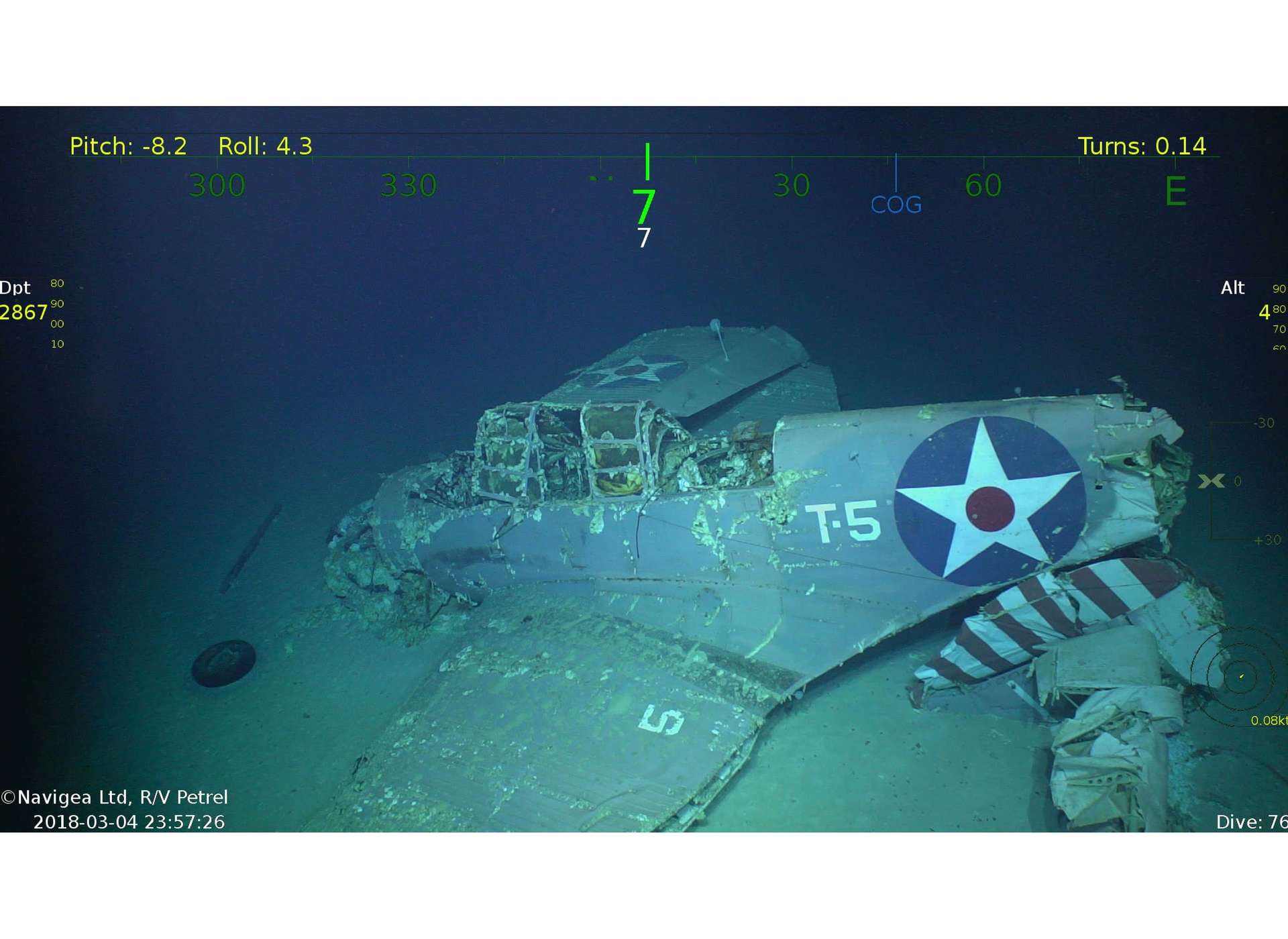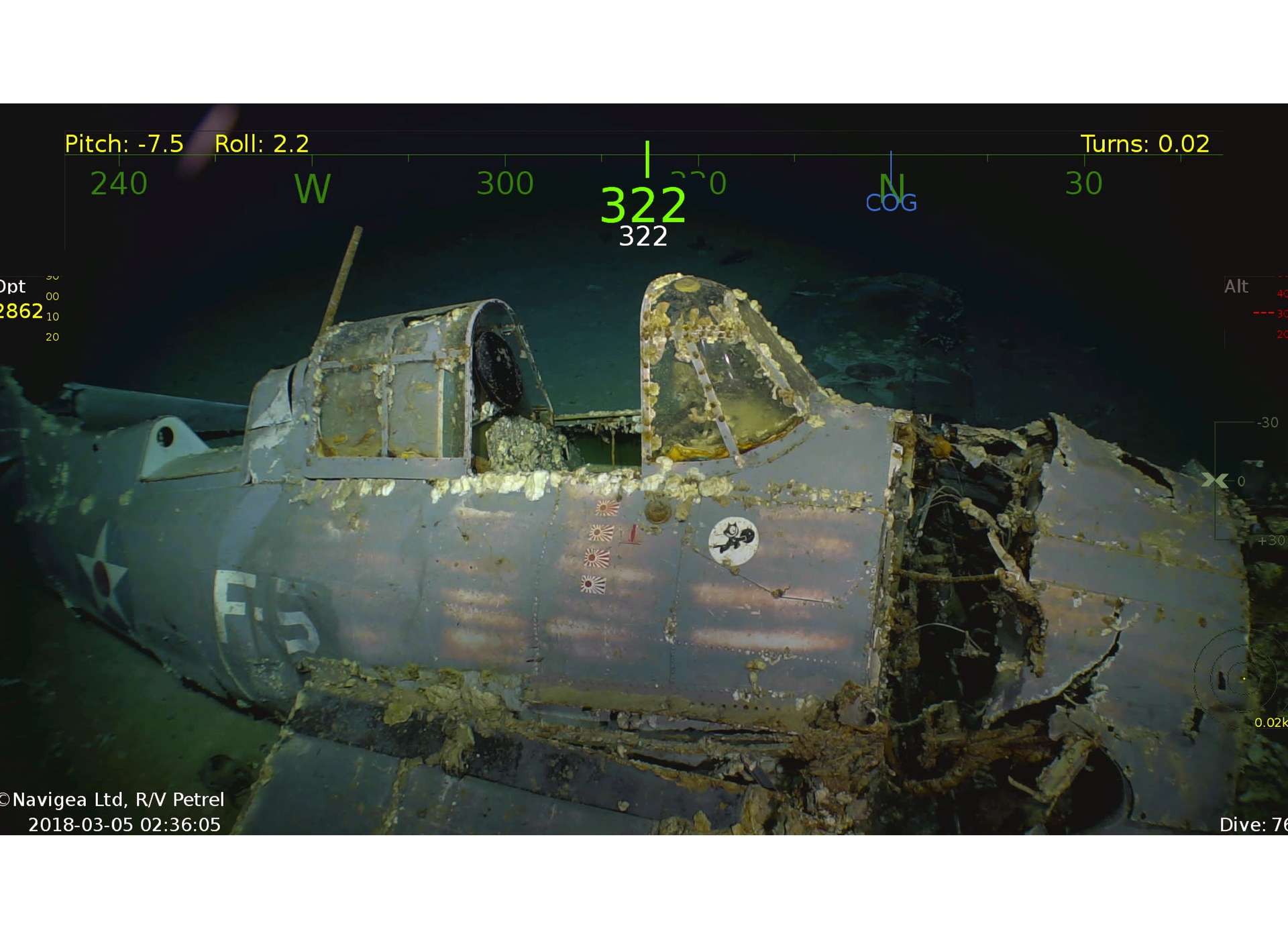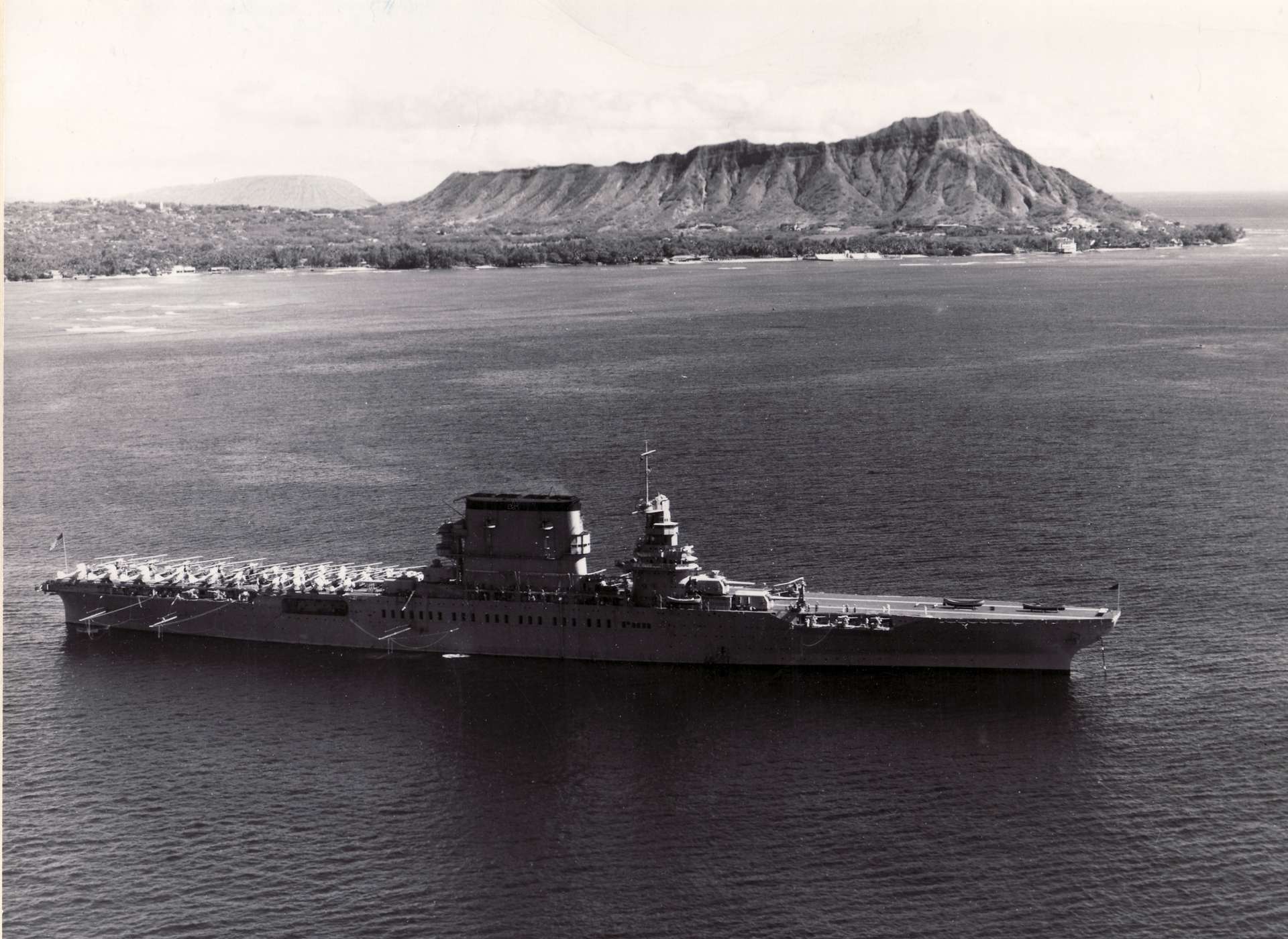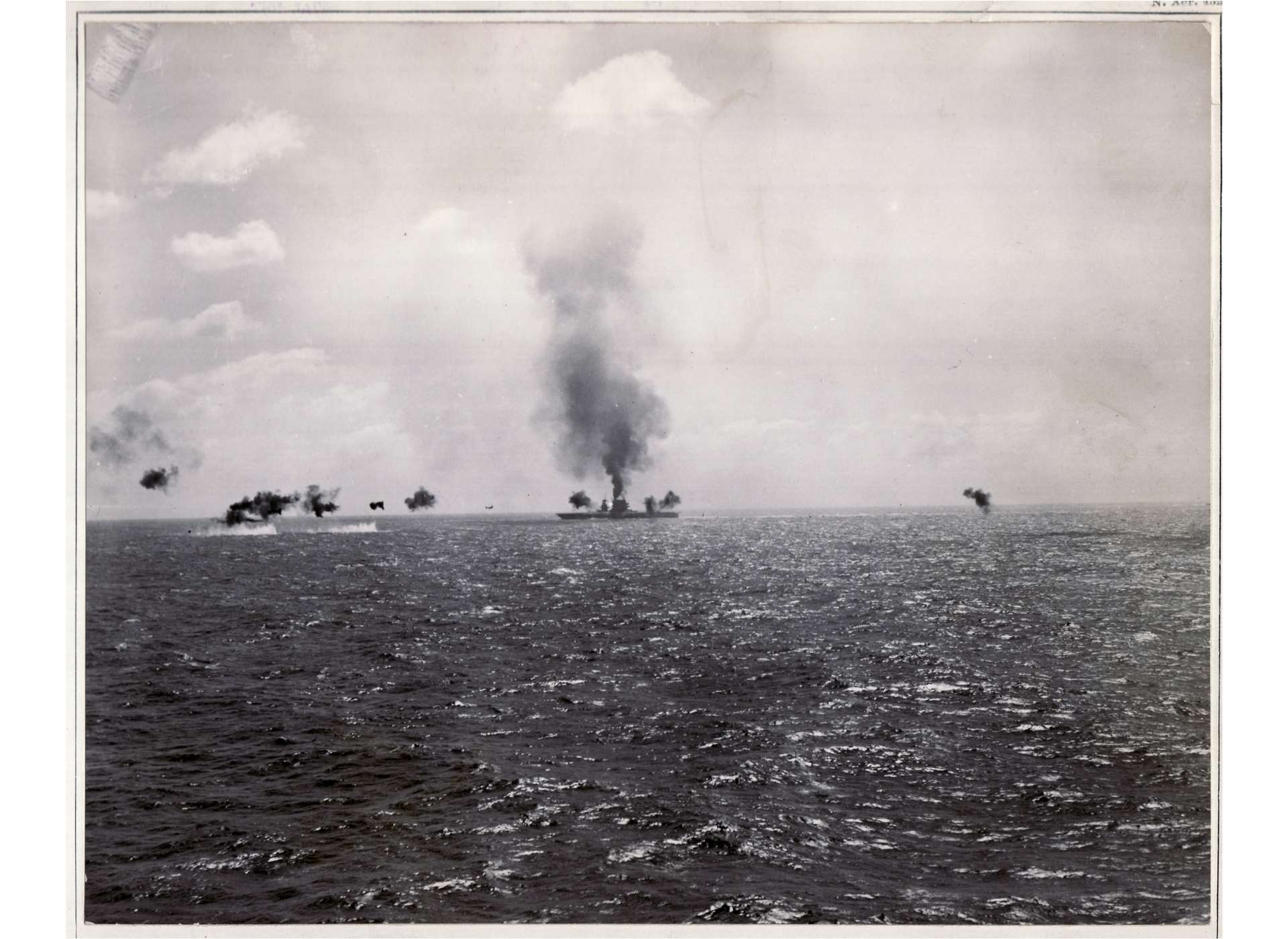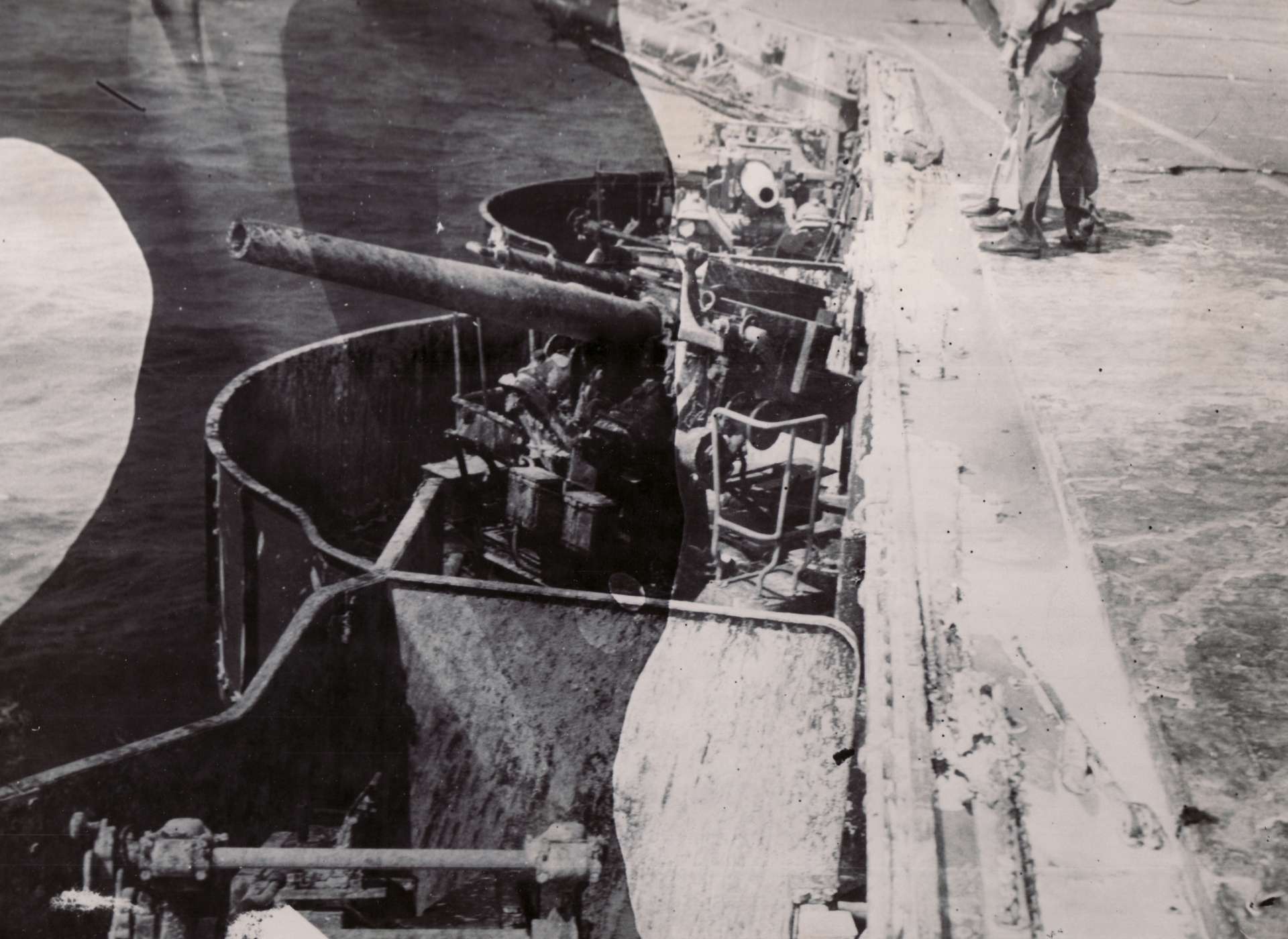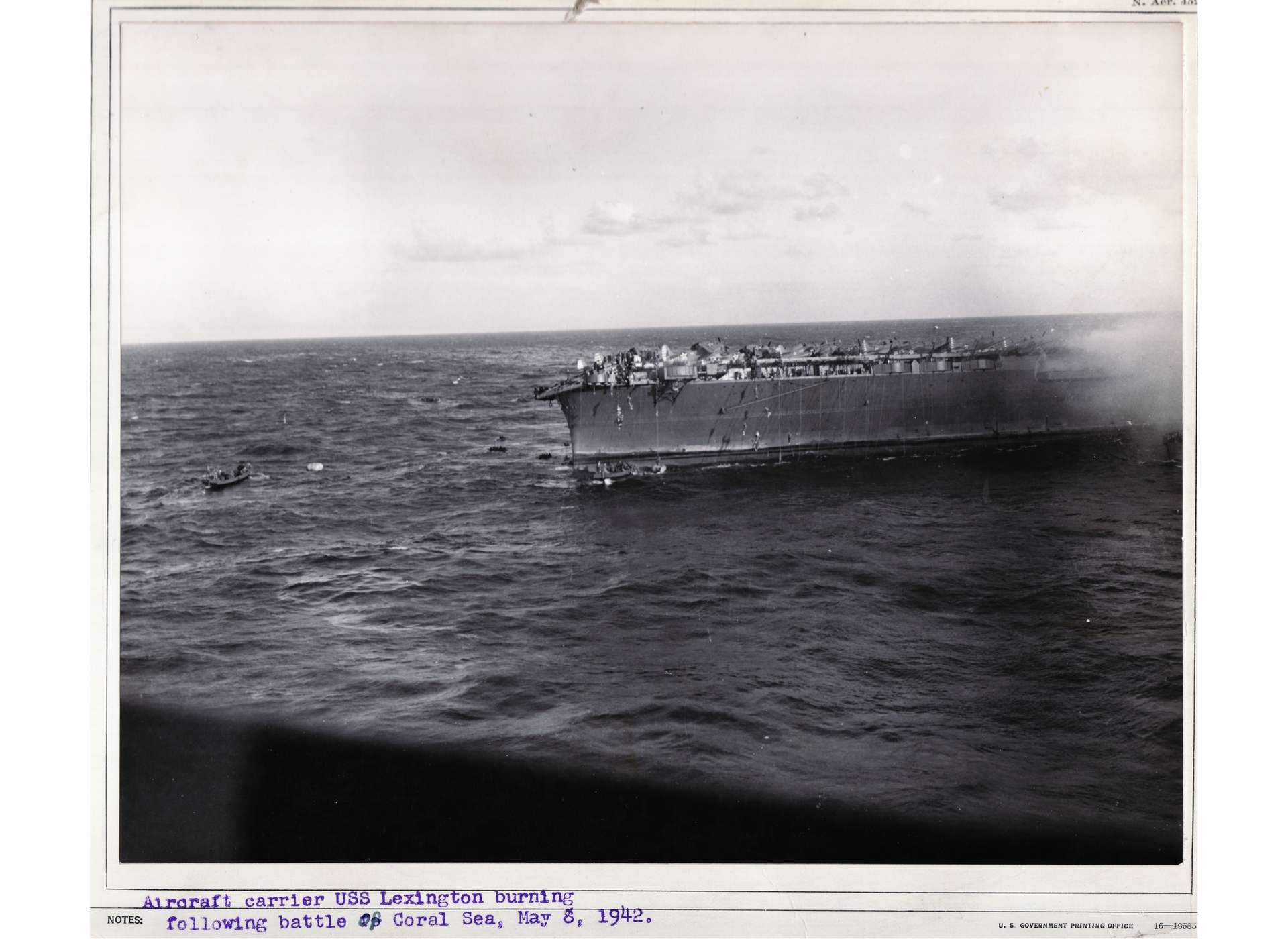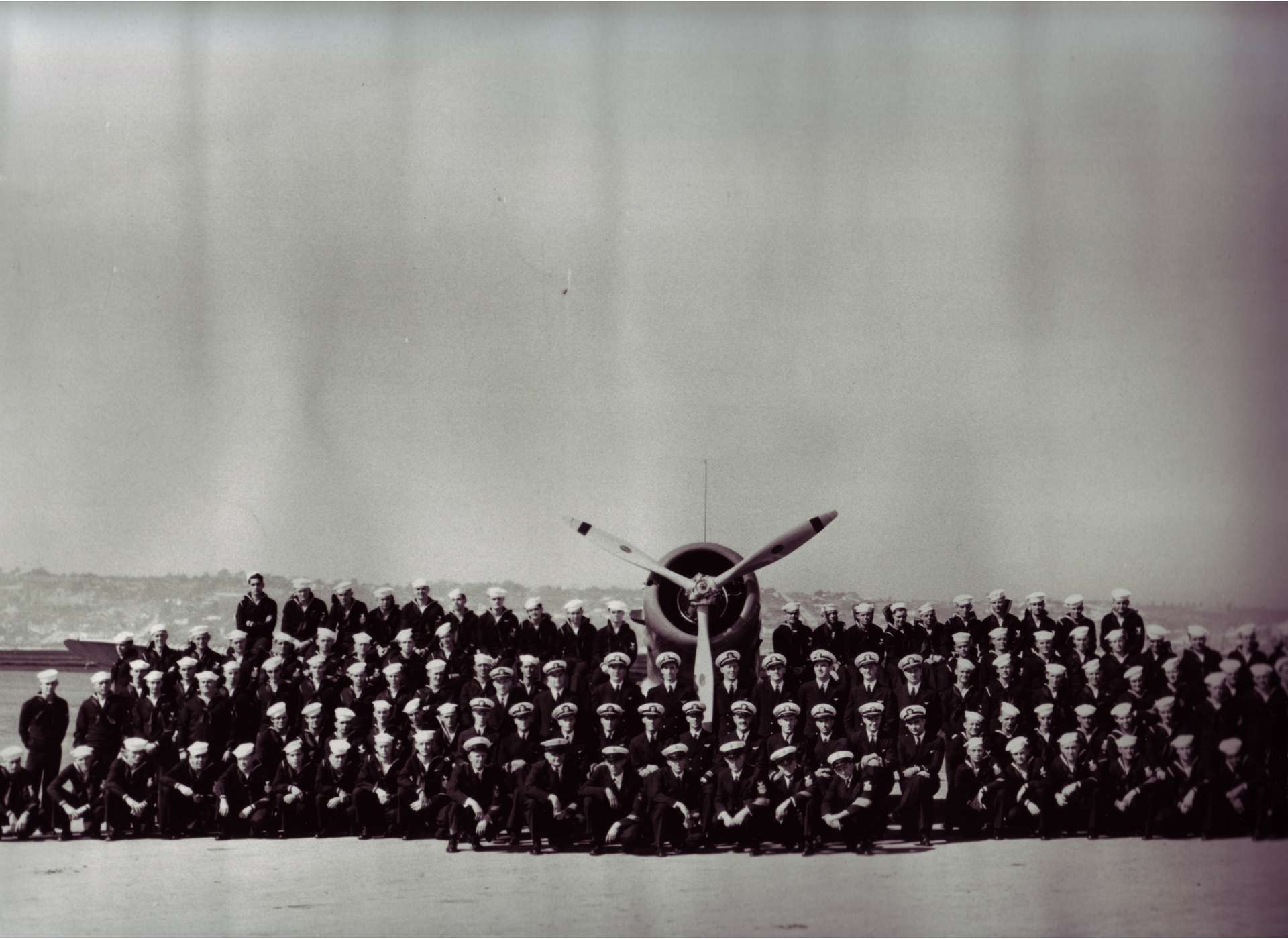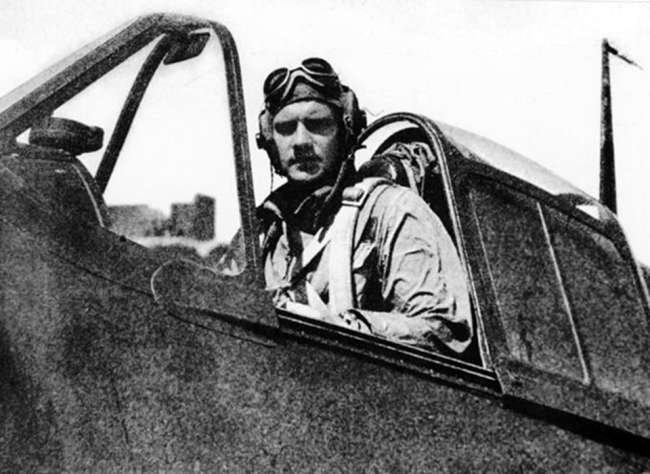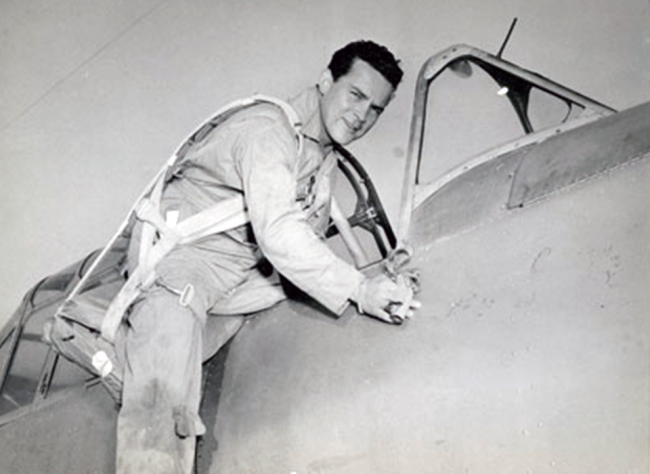The images are striking, both for their unbelievable clarity as well as their historical significance. Taken on the ocean floor, some 3,000 meters beneath the surface of the water, they give the viewer a glimpse into the not-too-distant past, showing a moment trapped forever in time in the cold depths of the Coral Sea. Images of the nameplate fill the screen: Lexington. The image of the after end (rear) of her flight deck is unmistakable, and so are her five-inch antiaircraft guns, still in train (active), staring blankly at the open ocean as if ready to fire again.
The USS Lexington, an aircraft carrier that sank during the Battle of the Coral Sea, known by her crew as “Lady Lex,” has been discovered after more than 76 years by philanthropist Paul G. Allen and his research vessel R/V Petrel. While the photos of the vessel are incredible, it’s not simply these images that excite me and several other Museum historians clustered around the screen, but also the images that follow of the many aircraft that “Lady Lex” carried, once thought to be lost forever.
The photos brought back by Allen’s team show blue-gray aircraft in incredible states of preservation. Red and white striped fabric rudder panels, and national insignias on the wings and fuselages with a bright red dot in the center—all these send shock waves through the small group of viewers.
One of the aircraft, an F4F Wildcat, displays a Felix the Cat insignia, the symbol of Fighting Squadron 3 (VF-3). The fuselage (the main body) of the fighter is emblazoned with four Imperial Japanese flags denoting four aerial victories by the pilot. Excited chills run up my spine as I view these images. The next sequence shows several of the rarest aircraft, all of them amazingly well-preserved. I immediately recognize the TBD Devastators of Lexington’s Torpedo Squadron 2 (VT-2). No other types of this aircraft survive today. For someone like me, a museum historian who has spent more than three-quarters of my life studying the Pacific war, the excitement of such a moment is nearly indescribable.
-

Walt Nelson’s TBD T-4 lies upside down on top of Gunner Talkington’s TBD T-9 some 3,000 meters beneath the surface of the Coral Sea. Image: Paul Allen.
-

A five-inch antiaircraft gun on Lexington's port side. Image: Paul Allen.
-

A TBD T-8 flown by Ensign C. Hamilton. Image: Paul Allen.
-

Lexington's name stamped on steel just below the flight deck on the starboard side aft. Image: Paul Allen.
-

The TBD T-5 flown by Ensign T.B.Bash. Image: Paul Allen.
-

A VF-2 Wildcat with VF-3 insignia and four kills lies on the ocean floor near the sunken Lexington. Image: Paul Allen.
After the initial elation at the discovery subsides, I begin to dig into the aircraft a little more deeply. The fuselage numbers are clearly visible on all of the TBDs. Any researcher knows that fuselage numbers can easily identify who flew in these aircraft. A quick look at a book written by a friend shows the flight roster for VT-2 on May 7, 1942.
By comparing the roster with the fuselage numbers, I can see that all of these recently photographed planes flew combat missions at the Battle of the Coral Sea. One particular aircrew stands out to me, however, a Devastator piloted by Lieutenant R.F. Farrington and crewed by Ted Wiebe and Walter Nelson. I instantly remember Walt Nelson, a friend I met only twice back in 2007 when I sat in his kitchen and recorded his oral history (below) for the Museum’s then-small but growing archive. Staring at the roster in the book and then the image of the plane upside down on the bottom of the Coral Sea is shocking and exciting—a tangible, visible link between my friend and a momentous event from World War II.
A Minnesota native, Walter Nelson volunteered for the Navy in Duluth in 1939. He took his boot training at Great Lakes Training Center, volunteered for Navy radio school, and requested duty aboard an aircraft carrier. Walt got his wish and was assigned to the USS Lexington in San Pedro, California. After reporting aboard and serving as a radioman, he volunteered for duty in Lex’s air group and was assigned as a radioman/gunner in Torpedo Squadron 2 in 1940. The TBD was an “excellent airplane for its time,” Walt said. “She was stable, slow, but stable and reliable.”
While the men of VT-2 had confidence in the Devastator, by the time Pearl Harbor was attacked on December 7, 1941, she was already an obsolete bird. Walt participated in the early hit-and-run carrier raids of the war—raids on an enemy power that were defined by their surprise entrance and rapid departure—and received his baptism of fire as his plane struggled over the Owen Stanley Mountains on the Lae-Salamaua Raid to strike enemy shipping in the New Guinea harbor on March 10, 1942. The small raid was just a warm-up for Walt and his comrades. Their real show began on the morning of May 7.
Walt got an early wake-up that morning. Reported contact with a Japanese aircraft carrier force prompted the aircrew’s early rise and preparation for combat. Just after 9:00 a.m., Lexington began launching her aircraft for a strike against the reported enemy. Forming up over their ship, Walt and his comrades in Lexington Air Group headed toward the last reported location of their enemy at 9:47 a.m.
Just under two hours later, Walt and the torpedo squadron spotted the small Japanese task force, their target staring back at them, unmistakable with her red national insignia on her flight deck. The Japanese escort carrier Shoho would soon feel the wrath of two full American air groups as Yorktown’s (CV-5) Air Group was only minutes behind Lex’s.
Lexington’s Air Group executed a perfectly coordinated attack on the small carrier. Walt’s squadron split into two groups to attack the enemy ship from two angles so that the ship would face incoming American torpedoes no matter which way she turned. Walt’s pilot, Farrington, approached Shoho from her port side, attempted to launch his torpedo only to have it hang up and not drop.
“He pickled the fish but it wouldn’t drop,” Walt said. “So he went around and made a run again. And this time it worked.” Farrington swung his plane around to approach Shoho from the starboard side and dropped his torpedo. As he pulled away, Walt watched their weapon impact the target. “It blew the whole bow right off that damned thing,” Walt said. “I seen it as we banked away and could look down.”
While Walt’s torpedo didn’t exactly blow the bow off Shoho, it did severely damage her. Suffering at least seven torpedo hits, five from Walt’s squadron alone, as well as several bomb hits from diving SBD Dauntless dive-bombers, Shoho sank while still in view of the retreating Americans. Walt and the VT-2 squadron had much to celebrate after returning to Lexington intact.
The success on May 7 only magnified May 8’s failures. As coordinated as the attack on Shoho had been, the attack on the enemy fleet carrier Shokaku was not. Failure in communications between air groups marred the attack. As accurate as the TBDs had been on May 7, they were inaccurate on May 8.
Despite claims to the contrary, not a single torpedo struck Shokaku on May 8. Her violent maneuvers and poor weather conditions allowed her to escape the fate suffered by her smaller sister the day before. SBDs screaming in from 20,000 feet managed to score several hits that did knock the massive carrier out of the battle, but despite her wounds she would survive until 1944, when she was sunk by the submarine Cavalla (SS-244).
Walt and his crew were disappointed and confused when they hopped back onto the deck of the Lexington. Walt immediately noticed something was wrong with his ship. She was listing to the port side and smoking. Shortly after Walt and the squadron had launched, Lexington came under attack and suffered two torpedo hits and two bomb hits from Japanese aircraft. At 12:47 p.m., an enormous explosion rocked the ship.
Fuel vapors had ignited from a cracked fuel bunker damaged in the Japanese torpedo attack. At 2:42 p.m., a second large explosion blasted the ship. Fuel vapors were again the culprit as severe fires sprouted throughout the giant ship. Another explosion occurred at 3:25 p.m., causing Lex to lose power and drift to a halt.
Sitting on the flight deck eating ice cream pilfered from the ship’s snack bar (which sailors called the “Gedunk stand”), Walt and his shipmates received orders to abandon ship. After attempting to pass one of the aircraft’s life rafts to his pilot in the water below (only to have it grabbed by a bunch of nearby sailors), Walt descended hand over hand down a line to the water below.
He floated around the ship for quite a while, never able to fully get away from Lex’s giant hull because of the currents surrounding the sinking carrier. Staring up at the flight deck, seeing his T-4 sitting there among 11 other TBDs, Walt felt sadness as he was scooped from the water by the destroyer Phelps (DD-360). “It was sad to see her go,” he said. “She was home for two years. Everything I had was aboard her.”
Later that evening, the Phelps was ordered to scuttle the Lexington, now a blazing inferno. The destroyer fired five torpedoes, finally sinking the beloved carrier. Lex went down on a nearly even keel, by the bow, disappearing from sight for the next 76 years.
-

Lexington anchored off Diamond Head, Oahu, Hawaii.
-

Lexington under attack from Japanese aircraft. Image: From the Collection of The National WWII Museum.
-

Damage to Lex's five-inch gun gallery. Footage of this damaged gallery can be seen in RV/Petrel's underwater imagery of the wreck. Image: From the Collection of The National WWII Museum.
-

Sailors abandon Lexington. TBD T-8 and F4F F-5 are visible on the flight deck starboard side. Image: From the Collection of The National WWII Museum.
-

Torpedo Squadron 2. Image: From the Collection of The National WWII Museum.
Walt Nelson would go on to serve in the Navy for 24 years, retiring in 1968 as a senior chief radioman. Unfortunately, he would not get the chance to see "Lady Lex" when she was rediscovered on March 4, 2018. Walt passed away on October 4, 2014, at the age of 94.
The discovery of the wreck of the Lexington, as well as her aircraft, has created quite a stir among Naval aviation historians. Those of us who were lucky enough to know men who sailed aboard her or flew from her flight deck are astonished at the images we have seen thanks to the efforts of the R/V Petrel and Paul G. Allen.
In a press release following the Lexington’s discovery, Allen said, “To pay tribute to the USS Lexington and the brave men that served on her is an honor.” Indeed it is. Lex’s discovery has awakened memories of heroic deeds performed by ordinary men, of a gallant ship and her crew, and of departed friends—men whom we should never forget.
Seth Paridon
Seth Paridon was a staff historian at The National WWII Museum from 2005 to 2020. He began his career conducting oral histories and research for HBO’s miniseries The Pacific and holds the distinction of being the first historian hired by the Museum’s Research Department. In the 12 years he was Manager of Research Services, Seth and his team increased the oral history collection from 25 to nearly 5,000 oral histories.
Cite this article:
MLA Citation:
APA Citation:
Chicago Style Citation:
